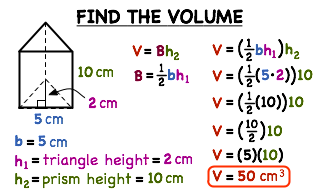
www.VirtualNerd.com
SUMMARY
- B stands for the area of the base
- Since our bases are triangles, we can use (1/2)bh for B
- We can call the height of the triangle h1 and the height of the prism h2 to avoid confusion
- Volume is measured in units cubed, so we have 50 cm3

NOTES

- The volume of a prism is V=Bh
- B is the area of the base of the prism
- h is the height of the prism
- The base of our prism is a triangle, so we can use (1/2)bh, the area of a triangle, for B
- We can call the height of the triangle h1 and the height of the prism h2 to avoid confusion

- V is the volume, which is what we are trying to find
- b is the base of the triangle, which is 5 cm
- h1 is the height of the triangle, which is 2 cm
- h2 is the height of the prism, which is 10 cm

- We can plug 5 in for 'b', 2 in for 'h1', and 10 in for 'h2' in our equation

- We need to use the order of operations to simplify the right hand side
- First multiply 5•2 in the innermost parentheses
- Then multiply (1/2)•10 within the next set of parentheses
- This is the same as 10/2, or 5
- Then multiply 5•10 to get 50 cm3







No comments:
Post a Comment